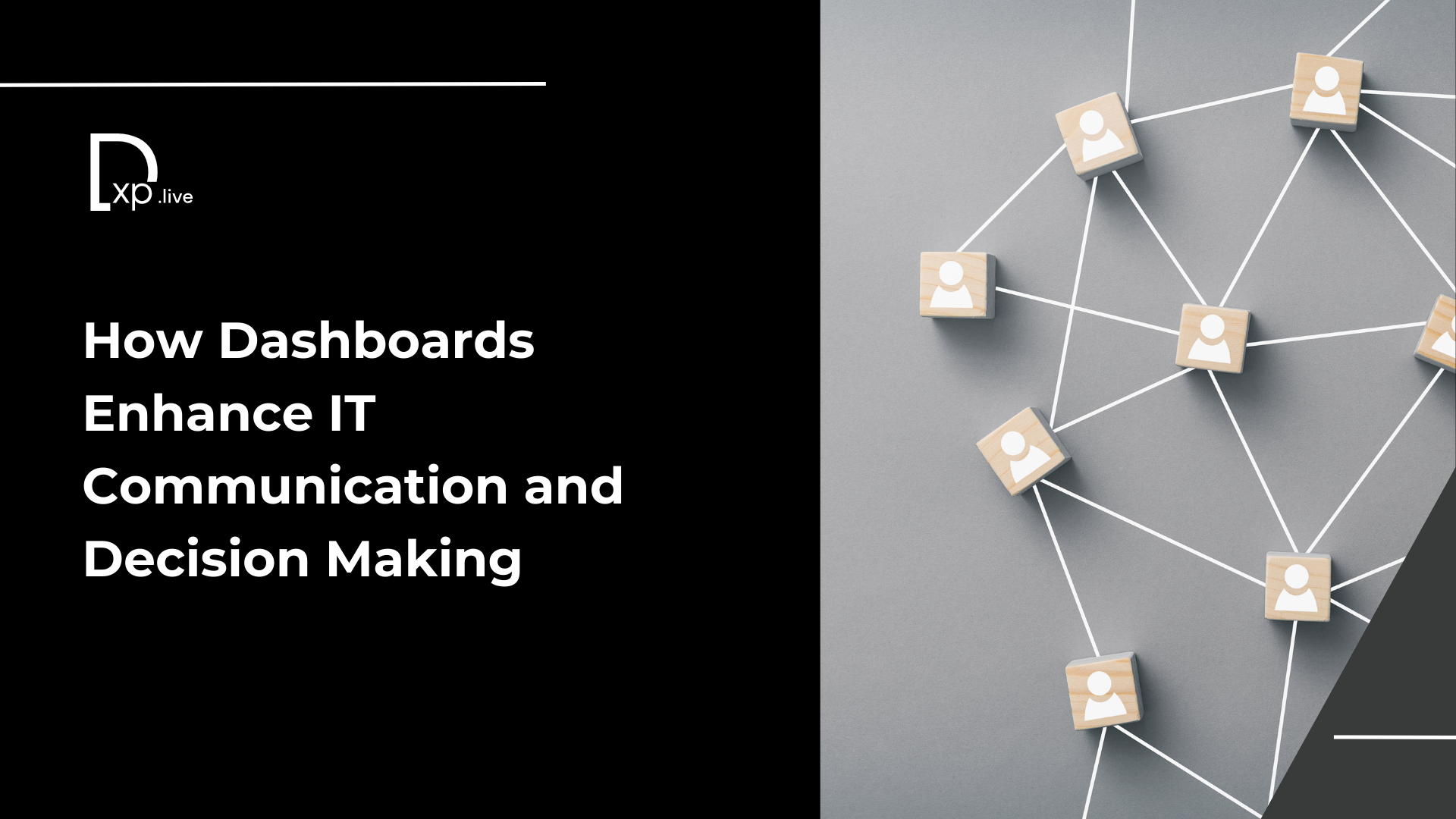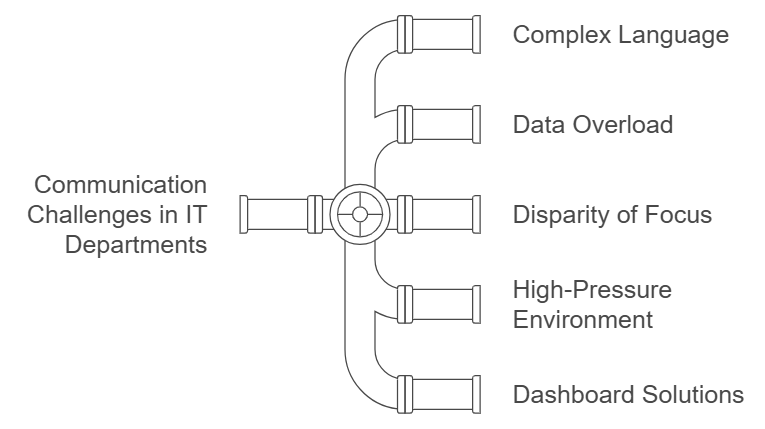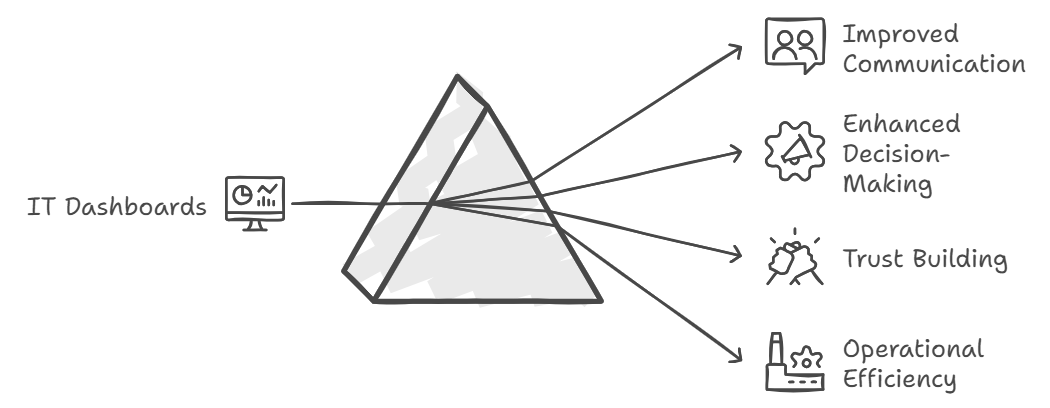How Dashboards Enhance IT Communication and Decision-Making

While IT communication is critical, IT departments regularly suffer from mismatched priorities and the difficulty of effectively communicating technical information to non-technical stakeholders. Such gaps in communication can make it difficult to arrive at a decision and lead to slow progress. But more than that, IT department dashboards are coming to the rescue! These tools provide real-time IT dashboards that connect the gap between technical and non-technical teams with clear, actionable insights. Visual representation of complex data, better workflow, and collaboration improvements — all these features foster seamless IT communication with dashboards. That said, for IT specifically, dashboards help drive faster decisions, transparency into processes, and a synced approach to addressing issues.
How do dashboards improve IT communication?
Dashboards simplify complex IT data by presenting it in clear, visual formats, making it easier for both technical and non-technical teams to understand. They provide real-time insights, improve decision-making, foster cross-department collaboration, and increase transparency, addressing many of the communication challenges IT departments face.
The Communication Struggles Facing IT Departments

IT departments are subject to a series of factors that disrupt effective communication, including the complex language of the IT professionals, complex meanings, disparity of interests, and working under high tension. Language issues usually arise with regard to IT-oriented professionals who use a language that other stakeholders do not understand. A great deal of time may also be wasted on overwhelming amounts of data produced by IT systems before actionable insights can be generated which probably at a fast rate almost impossible. Moreover, the disparity between the IT focus and the business focus can cause bottlenecks because each of the departments might have a different understanding of what is important for their objectives in a course of action. Apart from that, IT teams face constant pressure when it comes to system availability, security, and troubleshooting, which makes the decision-making and communication process more challenging.
Dashboards, in particular, are powerful tools because they can effectively assist in addressing communication barriers that exist within the IT departments. IT department real-time dashboards enable the decision-making process by providing ease in visualization and therefore speeding up the actions required. Dashboards meant for IT decision-making resolve issues such as overwhelming heaps of information out there by presenting concise and practical information that encourages teamwork and communication. Moreover, the advantages that dashboards pose to IT departments imply that communication between departments that are technical and non-technical can be enhanced.
How Dashboards Are Revolutionizing IT Communication
Dashboards are transforming IT communication by providing real-time, visual insights into system health and performance. These interactive tools consolidate crucial data, making it accessible for both technical and non-technical teams. In the face of common IT communication struggles, dashboards help bridge the gap, allowing seamless information sharing and quick decision-making.
By transforming complex data into intuitive visuals like charts, graphs, and gauges, dashboards ensure that key performance indicators (KPIs) are clear and actionable. This visual communication simplifies reporting and enhances collaboration across departments.
Real-time IT dashboards are crucial for IT teams, offering up-to-the-minute data that supports fast responses to issues and informed decisions. The ability to monitor system performance instantly helps prevent downtime and ensures better management of IT resources. Ultimately, dashboards are essential tools for IT departments, improving communication, efficiency, and decision-making processes across the organization.
Key Benefits of Dashboards for IT Communication

By displaying large amounts of complex information in a simpler visual way, dashboards provide the gap between IT communications to the audience, thus boosting its service, as they serve as an instrument for improving IT communication. Dashboards for IT should be a requirement since they help to explain technical jargon to the executives and managers as well as other interested parties without being lost in translation. With such clarity, IT communication woes are decreased which allows for proper understanding across the organization.
Another benefit that also cannot be ignored is the boost in making decisions. With IT dashboards, system performance, security, and project management are monitored in real-time allowing IT teams and decision-makers to respond efficiently and effectively.
This unified approach builds trust between IT and other business units. Instead, dashboards enable cross-department teamwork by eliminating borders and allowing everyone to access the same figures. And this openness strengthens trust between IT and other business units.
Moreover, they assist in solving issues much sooner than anticipated and therefore lead to operational efficiencies as problems do not easily get out of hand and IT departments are able to address issues before they become real concerns.
Real-World Examples: Dashboards in Action
In enterprise IT management, large organizations rely on IT department dashboards to monitor infrastructure, track network performance, and optimize resource allocation. These real-time IT dashboards improve communication between IT teams and other departments, leading to quicker decision-making and enhanced efficiency. By streamlining communication, dashboards help IT overcome common IT communication struggles and ensure that resources are utilized effectively.
In IT security monitoring, dashboards provide visibility into key security metrics such as vulnerability scans, threat detection, and system breaches. This real-time monitoring reduces response times and minimizes the risk of data breaches or downtime. The benefits of dashboards for IT are clear, offering enhanced visibility, faster decision-making, and a proactive approach to managing IT challenges.
Overcoming Common Challenges When Implementing Dashboards
Implementing dashboards in IT departments can significantly improve communication and decision-making, but several challenges need to be overcome. Data overload is a common issue, as too much information can overwhelm users. It’s crucial to focus on key metrics that drive meaningful insights and avoid clutter.
Another challenge is user adoption; without proper training and stakeholder buy-in, dashboards may not be utilized effectively. Ensuring that users understand the dashboard’s functionalities is essential.
Data quality and accuracy are also vital, as dashboards rely on up-to-date, reliable data. Poor data integration can undermine the effectiveness of real-time IT dashboards. Addressing these challenges can unlock the full potential of IT decision-making dashboards and improve overall IT communication and efficiency.
The Future of Dashboards in IT Communication
Dashboards are becoming radically transformative in the way IT communicates, you have machine learning and AI at play here; personalization, etc. With AI and machine learning being embedded into IT department dashboards, they can act as proactive decision-makers by predicting trends, detecting possible issues in the making, and even recommending solutions. This change will drastically cut down the confusion in IT communication, provide teams with actionable insights, and enhance decision-making processes.
Dashboards will evolve further with more personalization and indications of mobile optimization. Dashboards: Personalization will help in removing irrelevant data of stakeholders and reduce the communication gap between them. As remote work is becoming the norm, mobile-friendly dashboards will enable access to the IT dashboard on the go and assist in real-time decision-making. This is where the power of dashboards for IT comes in, facilitating highly agile communication and response to quickly changing IT environments.
In summary, dashboards are redefining IT communication by addressing common IT communication struggles through real-time data visualization and streamlined reporting. By presenting complex data in a clear, accessible format, dashboards enhance transparency and facilitate collaboration within IT departments and across other teams. Key benefits of dashboards for IT include better decision-making, quicker issue resolution, and a unified view of critical metrics. Real-time IT dashboards empower teams to respond to challenges efficiently, ultimately improving operational agility. As a valuable tool for modern IT environments, dashboards play a crucial role in bridging communication gaps and driving informed data-backed decisions.
Be at the forefront of technological innovation! Join our vibrant community to unlock expert insights, exclusive content, and the latest news on AI, IoT, and cutting-edge retail solutions. Stay informed, get inspired, and be part of the conversation—subscribe digitalexperience.live today for your gateway to the future!
FAQs:
1. How does a dashboard help in decision-making?
Dashboards simplify complex data, giving decision-makers quick access to real-time insights. This helps teams make faster, data-driven decisions and respond quickly to issues.
2. What is a dashboard in communication?
In communication, a dashboard displays key information visually, making it easy for teams to understand and share updates, track performance, and improve collaboration.
3. What is a dashboard, and why are dashboards so valuable to an organization’s decision-makers?
A dashboard is a tool that organizes important data in one view. It’s valuable because it provides clear, quick insights, enabling better, faster decisions across the organization.
4. How do data-driven dashboards enhance strategy implementation?
Data-driven dashboards keep teams aligned with real-time progress updates, helping them track goals, make adjustments, and stay on course with the strategy.



